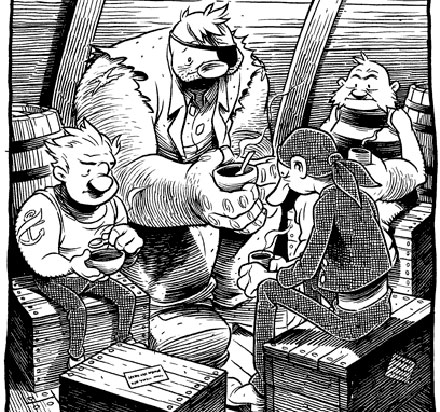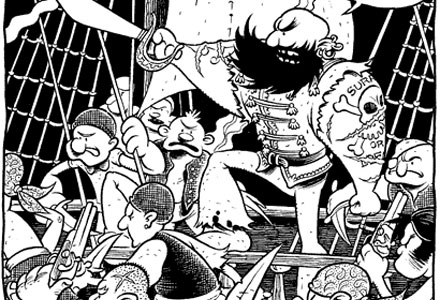DOUGLAS: Set to Sea, on the other hand, is the real thing: a one-off nautical action book (a hardcover version of Drew Weing’s sweet, lively web-comic) that’s a real pleasure to look at and linger over. Every panel-as-page just radiates joy in drawing. It owes a bit to “Popeye,” obviously (and I vaguely remember something E.C. Segar once said about how all he really knew about Popeye’s past was that there was a lot of pain in it), but I think the central moment of the story is the one where the protagonist realizes that his life is actually much better for all the suffering he’s endured.

MIKE: A nautical action book? It’s interesting to hear you say that, because that’s not really the way that I thought about it. Sure, there’s the big scene where the merchant ship our unnamed protagonist toils on is boarded by pirates, but other than that it wasn’t the action that sold me. To be fair, it was the art that sold me. When I opened this book and saw the first page, I immediately thought “Oh, a splash page.” Then I turned it over and saw another, and then another. I positively adore this format.
(More on Techland: “Batwoman: Elegy” and “Werewolves of Montpellier”)
As to the Popeye pedigree, I thought that as well, but I was looking at one of the two kidnappers in the beginning of the book when I thought it–the ham-fisted heavy with Olive Oyl-like legs. It was stylistic choices such as that character that stood out so vividly against the detailed and heavily crosshatched background work. I could pull half or more of the pages in this book and hang them as wall art.

DOUGLAS: Now I’m imagining a contemporary revival of Popeye with Alex Ross covers, with a hideously scarred one-eyed hero fighting Somali pirates, Alice the Goon tearing people in half… “They stole his Swee’Pea. Now the sailor man will have his revenge.”
MIKE: Back to the action, though. The scenes that I lingered on the longest were some of the quieter moments, as when the big lug throws his journal into the water, proclaiming his uninformed work “ridiculous.” Also great was the two-page sequence where a sailor falls from the rigging and then is silently mourned by his mates down below.
The lesson preached here is that no amount of clever wordplay can ever replace life experience? I wouldn’t call it a parable, as I’m not sure that spouting poetry about things you know nothing of is all that morally corrupt. But it does have that children’s storybook quality about it. Not in the way it’s executed, but in the fiber of the story. I don’t know that many children’s books that feature bar fights.
I gave this book one of my highest distinctions. I made my girlfriend read it.
EVAN: Man… this book! It starts off all pining and lonesome.
And then our nameless hero gets shot in the eye.
And all of it still works. That moment of violence doesn’t break the book. I think that’s because Weing creates a wonderful modulation of tone throughout Set to Sea. You can hear the book going from quiet to loud and back and forth again. That scene where Big Lug looks into the bookstore and sighs just about killed me. A din almost rises up from the page when that big battle scene happens; despite the fact that the panels have nary a sound effect, the clatter of swords and booming cannons comes across as clear as day. I also love that you can pinpoint the exact moment that Big Lug finds his poetry: it’s when they’re drinking after repelling the invading ship and the mates are toasting each other. The long wordless chunk in the third act doesn’t come across as a gimmick either; it’s just what it needs to be. Maybe it’s corny to call a book about a would-be poet lyrical, but that’s exactly what Set to Sea is.
(More on Techland: The Comic Book Club: X-Men, Superman and Parker)
GRAEME: Agreed with all of you. Set to Sea is just beautiful, emotional in all the right ways, and mixed with unexpected moments to pull it away from sugary sentiment and tweeness – Dude gets shot in the eye! Man! There’s such a gentleness here, so much heart, that it’s completely compelling, and the way Weing structured it, a panel a page, makes the reading experience wonderfully slow, to match the story.
What I also loved about it was how sparse it is; so much is brought to it by the reader, especially in terms of the implication of drinking/fighting/living that we don’t see, as time passes. There’s no hitting over the head with “This is what is important!” but it’s left up to us, which makes it more meaningful, somehow. I just really, really loved this book. Like you said, Douglas, this is the real thing.

